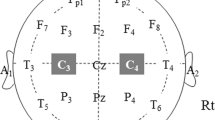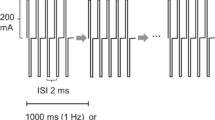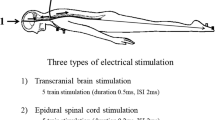Abstract
Objective.Clinical utility of high voltage repetitive transcranial electrical stimulation (TES) was investigated in 46 patients undergoing spine surgery. Methods.During spinal surgery, motor evoked potentials (MEPs) were recorded from upper or lower limb muscles following high voltage repetitive TES of motor cortex under propofol and opioid/N2O anesthesia. Results.The number of responses evoked by the double pulse stimulation was significantly higher than the single pulse stimulation. A similar finding was obtained when repetitive and single pulse stimulation was compared. Compound muscle action potentials (CMAPs) were recorded from upper and lower limbs in 4 patients with cervical spine myelopathy. The CMAP was absent on the affected side in 1 patient, which improved slightly after decompression. Radiculopathy was clinically present in 6 patients undergoing posterior lumbar decompression and fusion. No improvement of MEP was noted intraoperatively after spinal decompression and instrumentation. Conclusion.The findings suggest that intraoperative MEP monitoring is feasible method, however, its immediate prognostic value for adequacy of neuronal decompression and improvement requires further studies with larger patient population.
Similar content being viewed by others
REFERENCES
Aglio LS, Romero R, Desai S el al. The use of transcranial magnetic stimulation for monitoring descending spinal cord motor function. Clin Electroencephalogr 2002; 33: 30-41
Merton PA, Morton HB. Stimulation of the cerebral cortex in the intact human subject. Nature 1980; 285: 227
Rothwell JC, Thompson PD, Day BL et al. Stimulation of the human motor cortex through the scalp. Exp Physiol 1991; 76: 159-200
Edmonds HL, Paloheimo MPI, Backman MH et al.Transcranial magnetic motor evoked potentials (tc MMEP) for functional monitoring of motor pathways during scoliosis surgery. Spine 1989; 14: 683-686
Jones SJ, Harrison R, Koh KF et al. Motor evoked potential monitoring during spinal surgery: Responses of distal limb muscles to transcranial cortical stimulation with pulse trains. Electroencephalogr Clin Neurophysiol 1996; 100: 375-383
Pechstein U, Cedzich C, Nadstawek J et al. Transcranial high-frequency repetitive electrical stimulation for recording myogenic motor evoked potentials with the patient under general anesthesia. Neurosurgery 1996; 39: 335-343
Burke D, Hicks R, Stephen J et al. Assessment of corticospinal and somatosensory conduction simultaneously during scoliosis surgery. Electroencephalogr Clin Neurophysiol 1992; 85: 388-396
Kombos T, Suess O, Ciklatekerlio O, Brock M. Monitoring of intraoperative motor evoked potentials to increase the safety of surgery in and around the motor cortex 2001; 95: 608-614
Morota N, Deletis V, Constantini S et al. The role of motor evoked potentials during surgery for intramedullary spinal cord tumors. Neurosurgery 1997; 41: 1327-1336
Yang LH, Lin SM, Lee WY et al. Intraoperative transcranial electrical motor evoked potentials monitoring during spinal surgery under intravenous ketamine or etomidate anesthesia. Acta Neurochir 1994; 127: 191-198
Calancie B, Harris W, Brindle GF, Green B, Landy HJ. Threshold-level repetitive transcranial electrical stimulation for intraoperative monitoring of central motor conduction 2001; 95: 161-168
Calancie B, Klose KJ, Baier S et al. Isoflurane-induced attenuation of motor evoked potentials caused by electrical motor cortex stimulation during surgery. J Neurosurg 1991; 74: 897-904
Haghighi SS, Green D, Oro JJ et al. Depressive e¡ect of isoflurane anesthesia on motor evoked potentials. Neurosurgery 1990; 26: 993-997
Hicks R, Burke D, Stephen J et al. Corticospinal volleys evoked by electrical stimulation of human motor cortex after withdrawal of volatile anaesthetics. J Physiol 1992; 456: 393-404
Ubags LH, Kalkman CJ, Been HD et al. The use of ketamine or etomidate to supplement sufentanil/N2O anesthgesia does not disrupt monitoring of myogenic transcranial evoked responses. J Neurosurg Anesth 1997; 3: 228-233
Van Dongen EP, Ter Beek, HT, Schepens MA et al. Effect of nitrous oxide on myogenic motor potentials evoked by a six pulse train of transcranial electrical stimuli: A possible monitor for aortic surgery. Anaesthesia 1999; 82: 328-328
Kalkman CJ, Ubags LH, Been HD et al. Improved amplitude of myogenic motor evoked responses after paired transcranial electrical stimulation during sufentanil/N2O anesthesia. Anesthesiology 1995; 83: 270-276
Kalkman CJ, Drummond JC, Patel PM et al. Effects of droperidol, pentobarbital, and ketamine on myogenic transcranial magnetic motor-evoked responses in humans. Neurosurgery 1994; 35: 1066-1071
Van Dongen EP, Ter Beek HT, Schepens MA et al. Within-patient variability of myogenic motor-evoked potentials to multipulse transcranial electrical stimulation during two levels of partial neuromuscular blockade in aortic surgery. Anesth Analog 1999; 88: 22-27
Woodforth IJ, Hicks RG, Crawford MR et al. Variability of motor-evoked potentials recorded during nitrous oxide anesthesia from the tibialis anterior muscle after transcranial electrical stimulation. Anesth Analg 1996; 82: 744-749
Ellaway PH, Davey NJ, Maskill DW et al. Variability in the amplitude of skeletal muscle responses to magnetic stimulation of the motor cortex in man. Electroenceph Clin Neurophysiol 1988; 109: 104-113
Author information
Authors and Affiliations
Rights and permissions
About this article
Cite this article
Haghighi, S.S. Monitoring of Motor Evoked Potentials with High Intensity Repetitive Transcranial Electrical Stimulation during Spinal surgery. J Clin Monit Comput 17, 301–308 (2002). https://doi.org/10.1023/A:1021210507928
Issue Date:
DOI: https://doi.org/10.1023/A:1021210507928




